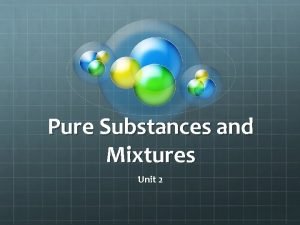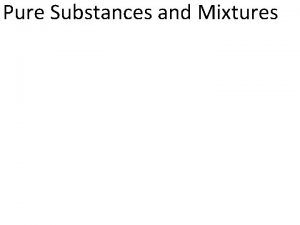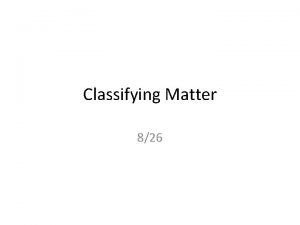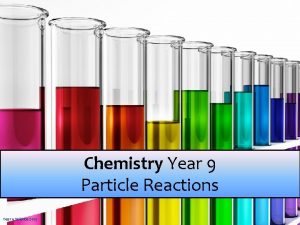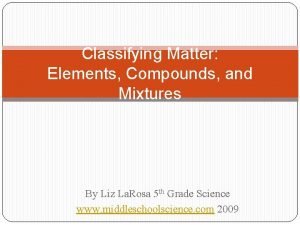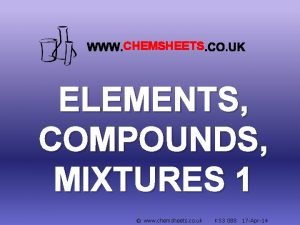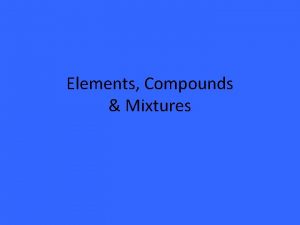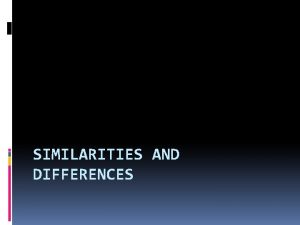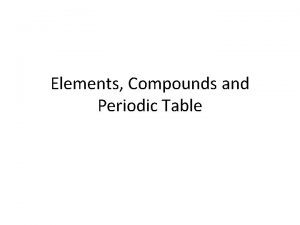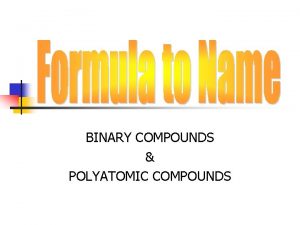Elements vs Compounds Similarities Elements and compounds are











- Slides: 11

Elements vs Compounds - Similarities • Elements and compounds are both pure substances • This means that they can’t be broken down into simpler substances by physical means

Elements vs Compounds - Differences • Elements are made of only one type of atom (in other words, it is a pure element) and therefore can’t be broken down into simpler substances. • Iron is only made of iron atoms, oxygen is only made of oxygen atoms, carbon is only made of carbon atoms, and so on.

Elements vs Compounds - Differences • Compounds are made of two or more different types of atoms (in other words, two or more elements), and can only be separated by chemical means • Water is made of hydrogen and oxygen (H 2 O), salt is made of sodium and chlorine (Na. Cl), and sugar is made of carbon, hydrogen, and oxygen (C 6 H 12 O 6)

Mixtures • Mixtures are created when different elements and compounds are physically combined and each “ingredient” keeps its own properties. No chemical changes or reactions take place! • Mixtures are NOT pure substances because they can be separated physically. • There are two types of mixtures: heterogeneous and homogeneous

Mixtures • Heterogeneous mixtures are not uniform throughout, so you can see the different parts that make up the mixture • Hetero = different • Homogeneous mixtures are uniform throughout, so you can’t distinguish • Homo = same


Periodic Table • Element Name • Atomic Number • Number of protons and electrons • Element Symbol • Always starts with a capital letter • Atomic Mass

Periodic Table • Gold is only made of gold atoms, and since it is a chemical element it can’t be broken down into simpler substances. • One atom of gold has: • 79 protons (atomic number) • 79 electrons (same as protons) • 118 neutrons (atomic mass minus atomic number)

Chemical Formulas • Chemical formulas are like the “ingredients” of a compound. • Common chemical formulas are H 2 O (water), CO 2 (carbon dioxide), C 6 H 12 O 6 (sugar), Na. Cl (salt), HCl (hydrochloric acid), and C 3 H 8 (propane). • This tells you what elements make up a compound and how many atoms there are of each element.

Subscripts and Coefficients • Subscripts are the small numbers after a chemical symbol. The subscript tells you how many atoms there are of that element. • Coefficients are the big numbers in front of the whole chemical formula. The coefficient tells you how many molecules there are of that compound.

Counting Atoms • To count the number of atoms present in a chemical formula or equation, you must list the elements that are present, and then multiply the coefficient by the subscript. • Remember, if there is no subscript this always means 1!
 Insidan region jh
Insidan region jh Ionic and covalent bonds venn diagram
Ionic and covalent bonds venn diagram Compounds mixtures and elements worksheet
Compounds mixtures and elements worksheet Different types of mixtures
Different types of mixtures Elements, compounds and mixtures worksheet with answers
Elements, compounds and mixtures worksheet with answers Study jams mixtures
Study jams mixtures Is a bag of m&ms a mixture or pure substance
Is a bag of m&ms a mixture or pure substance Elements and compounds examples
Elements and compounds examples Difference between mixture and compund
Difference between mixture and compund Types of matter elements compounds and mixtures
Types of matter elements compounds and mixtures Elements compounds and mixtures ks3
Elements compounds and mixtures ks3 Chemistry in biology section 2 chemical reactions
Chemistry in biology section 2 chemical reactions



